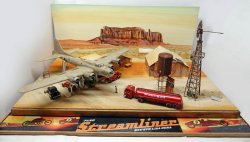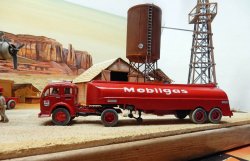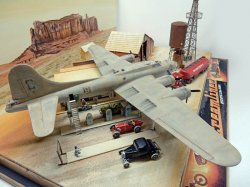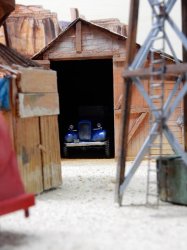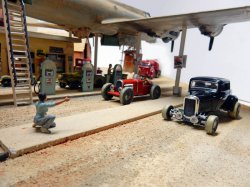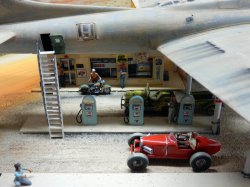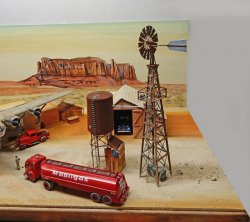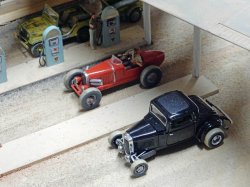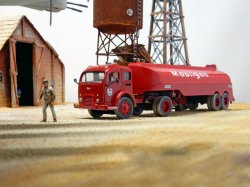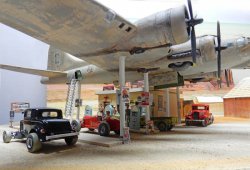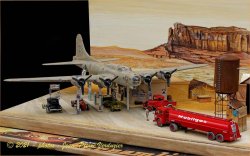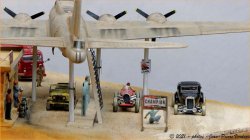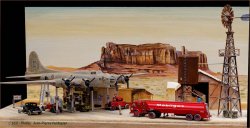
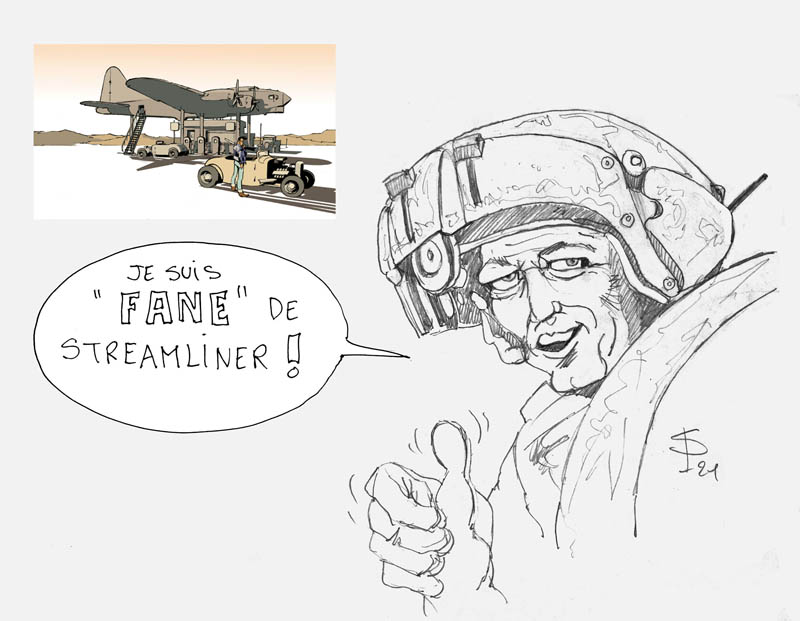
Streamliner est une bd française en deux tomes.
B17 - "La forteresse volante"
Le fer de lance des bombardements Alliés en Europe.
Créé par la firme Boeing, possédant 4 moteurs Wright développant 1 200 ch chacun, fortement blindé, résistant à de nombreux impacts, capable de revenir à la base avec un seul moteur, ou l'empennage endommagé. Grande autonomie de vol. Premier vol en 1935, il sera vraiment opérationnel qu'en 1942.
Armement : 13 mitrailleuses de calibre 50mm. 2,7 Tonnes de bombes environ pouvant aller jusqu'à 10 tonnes.
10 hommes d'équipage.
Polémique...
Le Bomber Command déversera, en mars-avril 1945, plus de 10 000 tonnes de bombes sur l’Allemagne, soit plus que pendant les 30 mois de septembre 1939 à mars 1942.
Mais la population française a payé aussi un lourd tribu...
Les anglais et les américains, très logiquement tout au long de la guerre, sont dans une logique de massification, selon laquelle ils cherchent à tirer le meilleur parti de ce qui fait leur force – leur puissance industrielle – de manière à assurer la victoire.
Le but en France est d'anéantir les usines, chemins de fer, aérodromes qui fournissent à l'occupant des moyens de continuer la guerre.
Les B17 bombardent en tapîs à 6 000m et on comprend qu'ils arrosent - quand ils arrivent à les toucher - leur cible mais surtout les quartiers civils et la population tout autour. Leur cible se situant souvent près des villes, voir au centre. L'apparition des viseurs Norden sensés pointer sur l'objectif avec précision est loin d'être efficace...
On constate de nombreux cas où les bombardements laissent intactes la cible tout en frappant de plein fouet une zone d’habitations ; ou le cas, où les installations visées sont bien atteintes, tant bien que mal, mais au prix d’un copieux arrosage des quartiers environnants (le centre de Nantes quasiment anéanti en 3 attaques faisant 1 400 morts). Ce dernier cas est le plus répandu, si bien qu’on peut le qualifier, non pas de bavure ou d’accident, mais d’élément structurel des bombardements alliés du continent européen.
Malgré les recommandations d'Eisenhower sur les populations amies, les chefs de la 8ème U.S. AIR FORCE n'en tiennent pas souvent compte. Si la R.A.F. est plus précise et utilise souvent des chasseurs-bombardiers pour des objectifs comme des ponts, elle utilise des bombes à retardement qui tuent bon nombre de personnes après la vague lors de l'organisation des secours. Les Alliés rechignent à armer la Résistance qui souvent serait plus efficace dans les sabotages avec moins de pertes en vies civiles.
Au point qu'en 1944, les Alliés sont appelés les "Libératueurs" par la population française, même si celle-ci les accueille dignement, consciente de l'aide apportée et d'ailleurs elle participera à l'évacuation des équipages survivants, enterrant les morts avec respect pendant toute la guerre. Cette impopularité affecte davantage les américains que les anglais réputés plus civilisés et meilleurs aviateurs...
Entre 1962 et 1973, les avions de l’U.S. AIR FORCE déverseront environ 4 millions de tonnes de bombes sur son allié, le Vietnam du Sud…Mais ceci est une autre histoire...
Streamliner is a French comic book in two volumes.
B17 - "The Flying Fortress
The spearhead of Allied bombing in Europe.
Created by the Boeing company, with 4 Wright engines developing 1,200 hp each, heavily armored, resistant to numerous impacts, capable of returning to base with only one engine, or the tail damaged. Great autonomy of flight. First flight in 1935, it will be really operational only in 1942.
Armament : 13 machine guns of 50mm calibre. 2.7 tons of bombs that can go up to 10 tons.
10 men crew.
Controversy...
In March-April 1945, the Bomber Command dropped more than 10,000 tons of bombs on Germany, more than during the 30 months from September 1939 to March 1942.
But the French population also paid a heavy price...
The British and the Americans, very logically throughout the war, are in a logic of massification, according to which they try to make the most of what makes their strength - their industrial power - in order to ensure the victory.
The aim in France was to destroy the factories, railroads and airfields that provided the occupying forces with the means to continue the war.
The B17s bombed from a distance of 6,000 meters, and it is understandable that they sprayed - when they managed to hit them - their target, but above all the civilian neighborhoods and the surrounding population. Their target is often located near the cities, even in the center. The appearance of the Norden sights which are supposed to point at the target with precision is far from being efficient...
There are many cases where the bombings leave the target intact while hitting a residential area; or the case where the targeted installations are well reached, but at the price of a copious spraying of the surrounding districts (the center of Nantes almost annihilated in 3 attacks making 1 400 deaths). This last case is the most widespread, so much so that it can be qualified, not as a blunder or an accident, but as a structural element of the allied bombings of the European continent.
In spite of Eisenhower's recommendations on friendly populations, the leaders of the 8th U.S. AIR FORCE did not often take them into account. While the R.A.F. was more precise and often used fighter-bombers for targets such as bridges, it used time bombs that killed many people after the wave during the relief effort. The Allies were reluctant to arm the Resistance, which would often be more effective in sabotage with less loss of civilian life.
To the point that in 1944, the Allies were called the "Killer liberators" by the French population, even though the latter welcomed them with dignity, aware of the help they had provided and, moreover, participated in the evacuation of the surviving crews, burying the dead with respect during the entire war. This unpopularity affected the Americans more than the English, who were reputed to be more civilized and better aviators...
Between 1962 and 1973, the planes of the U.S. AIR FORCE will pour about 4 million tons of bombs on its ally, South Vietnam...















